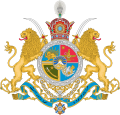Faravahar

Faravahar (OP *Pravarti > MP: prʾwhr)[1] is one of the best-known symbols of Zoroastrianism, the state religion of ancient Iran. This religious-cultural symbol was adapted by the Pahlavi dynasty to represent the Iranian nation.
The etymology of Paravahar is the Middle Persian root /prwr/ (the Pahlavi script of Middle Persian did not represent short vowels), and the word is thus variously pronounced/written Parohar, prohar, prawahr, pravahr and so forth, as there is no agreed upon method of transliterating the Middle Persian word into English. In Dekhoda's dictionary and the 17th-century Persian dictionary Burhan Qati', it appears as فروهر "puruhar". The Encyclopedia Iranica renders it as prawahr (this reflects the Pazend dibacheh form, corresponding to Book Pahlavi prʾwhr).
The winged disc has a long history in the art and culture of the ancient Near and Middle East. Historically, the symbol is influenced by the "winged sun" hieroglyph appearing on Bronze Age royal seals (Luwian SOL SUUS, symbolizing royal power in particular) [citation needed]. In Neo-Assyrian times, a human bust is added to the disk, the "feather-robed archer" interpreted as symbolizing Ashur.
While the symbol is currently thought to represent a Pravashi (approximately a guardian angel) and from which it derives its name (see below), what it represented in the minds of those who adapted it from earlier Mesopotamian and Egyptian reliefs is unclear. Because the symbol first appears on royal inscriptions, it is also thought to represent the 'Divine Royal Glory' (Khvarenah), or the Pravashi of the king, or represented the divine mandate that was the foundation of a king's authority.
This relationship between the name of the symbol and the class of divine entities it represents, reflects the current belief that the symbol represents a Fravashi. However, there is no physical description of the Fravashis in the Avesta, the sacred texts of Zoroastrianism, and in Avestan the entities are grammatically feminine.
In present-day Zoroastrianism, the faravahar is said to be a reminder of one's purpose in life, which is to live in such a way that the soul progresses towards frasho-kereti, or union with Ahura Mazda, the supreme divinity in Zoroastrianism. Although there are a number of interpretations of the individual elements of the symbol, none of them are older than the 20th century.
-
Persepolis, Iran.
-
A Neo-Assyrian "feather robed archer" figure, symbolizing Ashur. The right hand is extended similar to the Faravahar figure, while the left hand holds a bow instead of a ring (9th- or 8th-century BC relief).
-
The Faravahar portrayed in the Behistun Inscription
-
National bank of Iran (1946) containing the Farvahar icon.
-
Recent image of National Bank of Iran.
-
Tomb of Ferdowsi in Mashhad/Tous, Iran, containing Farvahar icon.
-
A Zoroastrian fire temple in Yazd, Iran.
-
Stone carved Faravahar in Persepolis.
In Iranian Culture
Even after the Islamic conquest of Iran, Zoroastrianism continued to be part of Iranian culture. Throughout the year, festivities are celebrated such as the Iranian New Year or Newroz, Mehregan, and ChaharShanbe Souri. These are remnants of Zoroastrian traditions. The symbol wings represent the sacred male and sacred female parts of the human brain, which, when connected or being used together, form a receiver of divine blessings from the creator. You must first connect with your spiritual eye. (not chakra eye/Egyptians called it the "eye of horus". It resides in all of us-it is us in spritual form.)[citation needed] From the start of the 20th century, the Farvahar icon found itself in public places and became a known icon amongst all Iranians.
The Shahname by Ferdowsi is Iran's national epic and contains stories (partly historical and partly mythical) from pre-Islamic Zoroastrian times. The tomb of Ferdowsi which is visited by numerous Iranians every year, contains the Farvahar icon as well.
After the Islamic Revolution of 1979, the Lion and Sun, which was part of Iran's original national flag, was banned by the government from public places in order to prevent people from being reminded of life prior to the revolution. Nevertheless, Farvahar icons were not removed. As a result, the Farvahar icon became a national symbol amongst the people, and it became somewhat tolerated by the government as opposed to the Lion and Sun. The Farvahar is the most worn pendant amongst Iranians and has become a national symbol, rather than a religious icon, although its Zoroastrian roots are certainly not ignored.
Gallery
-
Photo taken of a Zoroastrian Iranian in Tehran, Iran during the festivities of Mehregan.
-
A Zoroastrian Iranian in New York, wearing a Farvahar pendant.
-
An artwork from Iran depicting the Farvahar icon.
-
A young man wearing a Farvahar tattoo on his back.
-
Imperial coat of arms prior to the Revolution, containing Farvahar icon.
References
- ^ The Encyclopedia Iranica gives several Middle Iranian renderings: Praward, Prawahr, Prōhar, Prawaš, Prawaxš. The form Prawahr reflects the Pazend dibacheh form, corresponding to Book Pahlavi prʾwhr).






